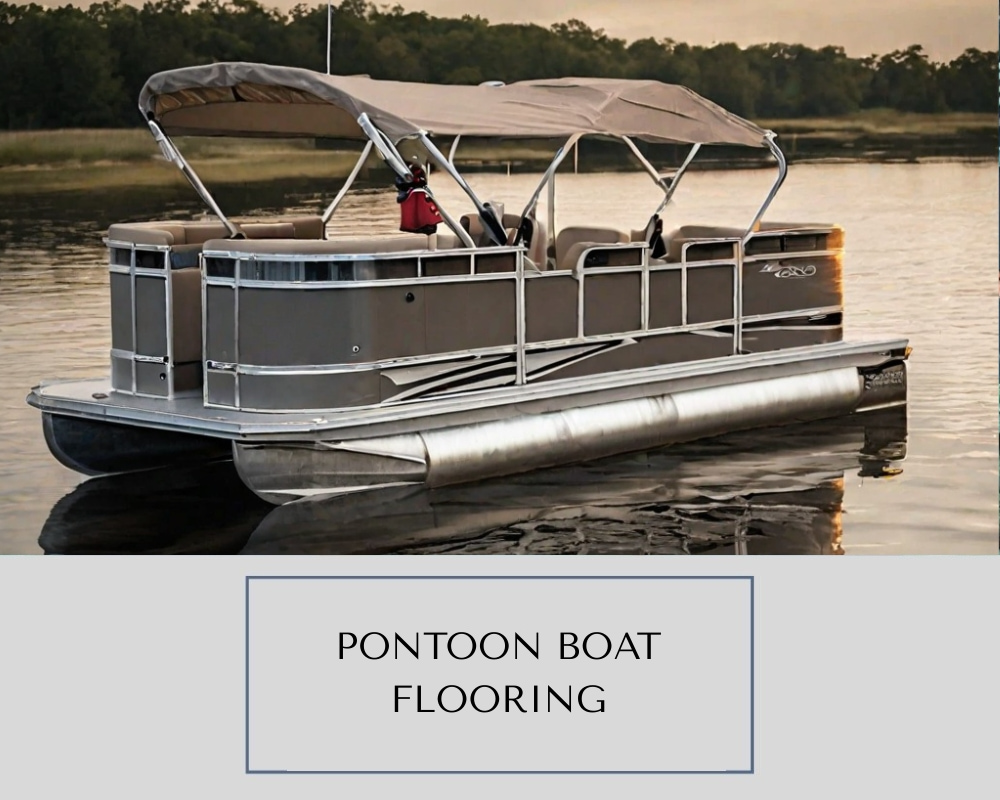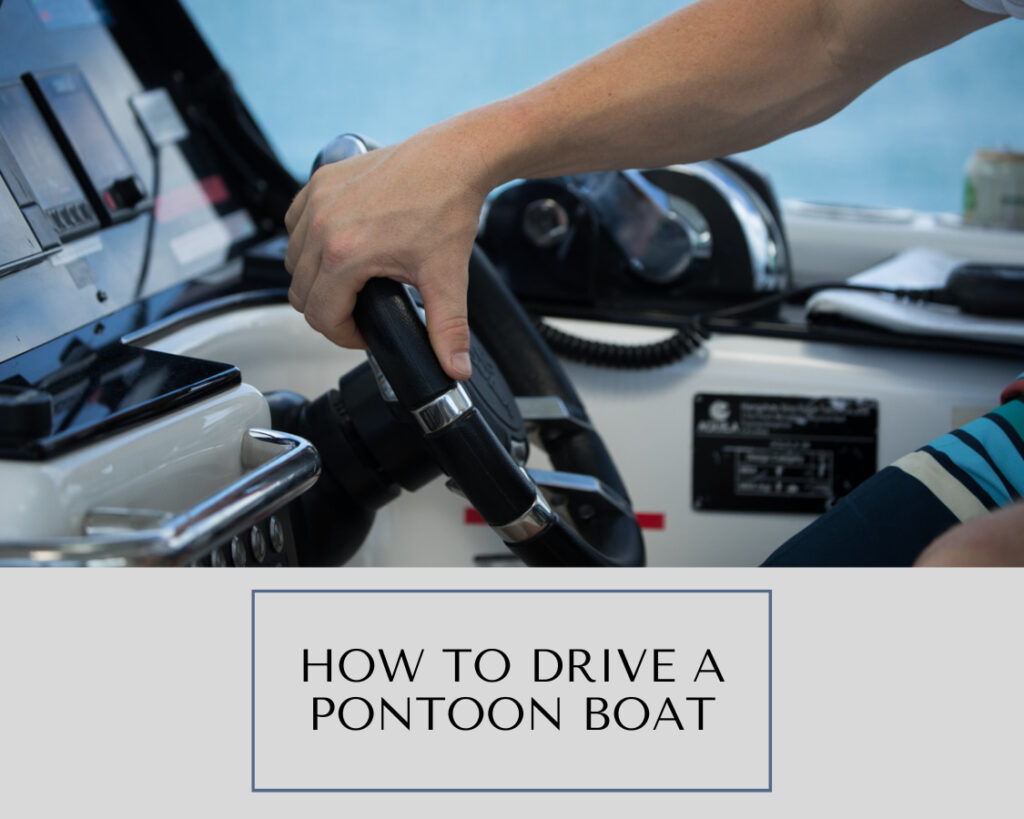When it comes to pontoon boats, the flooring you choose is not just a matter of aesthetics; it’s about comfort, durability, and the overall experience on the water. Whether you’re refurbishing an old pontoon or customizing a new one, selecting the right flooring is crucial for ensuring an enjoyable journey and the longevity of your boat.
In this blog, we’ll explore the three best pontoon boat flooring options that combine style, functionality, and ease of maintenance. We’ll delve into the pros and cons of each option, provide installation tips, and help you make an informed decision that aligns with your needs and budget.
So, let’s set sail on this flooring adventure and discover how to transform your pontoon into a floating paradise with the perfect foundation underfoot.
Marine Grade Carpet: The Classic Choice for Comfort and Style
Marine-grade carpet has long been the go-to choice for pontoon boat owners looking for a combination of comfort and style. Its plush texture offers a welcoming surface that’s perfect for those leisurely days spent cruising and lounging on the water.
Marine-grade carpet is crafted to withstand the harsh marine environment. Made from high-quality synthetic fibers, it’s engineered to resist the damaging effects of moisture, mold, and the sun’s UV rays, ensuring it remains vibrant and durable season after season.
Advantages
There are many advantages to marine grade carpets. It provides excellent traction, reducing the risk of slips and falls, and its sound-dampening properties help create a quieter, more serene boating experience. Additionally, the variety of colors and patterns available allows for full customization to reflect your personal style and complement your boat’s design.
Installation and Maintenance
When it comes to installation, marine-grade carpets can be a DIY-friendly project for those who are handy. It requires a clean deck surface and a suitable adhesive to secure it in place. As for maintenance, regular cleaning with mild soap and water, along with prompt attention to spills, will keep your carpet looking like new.
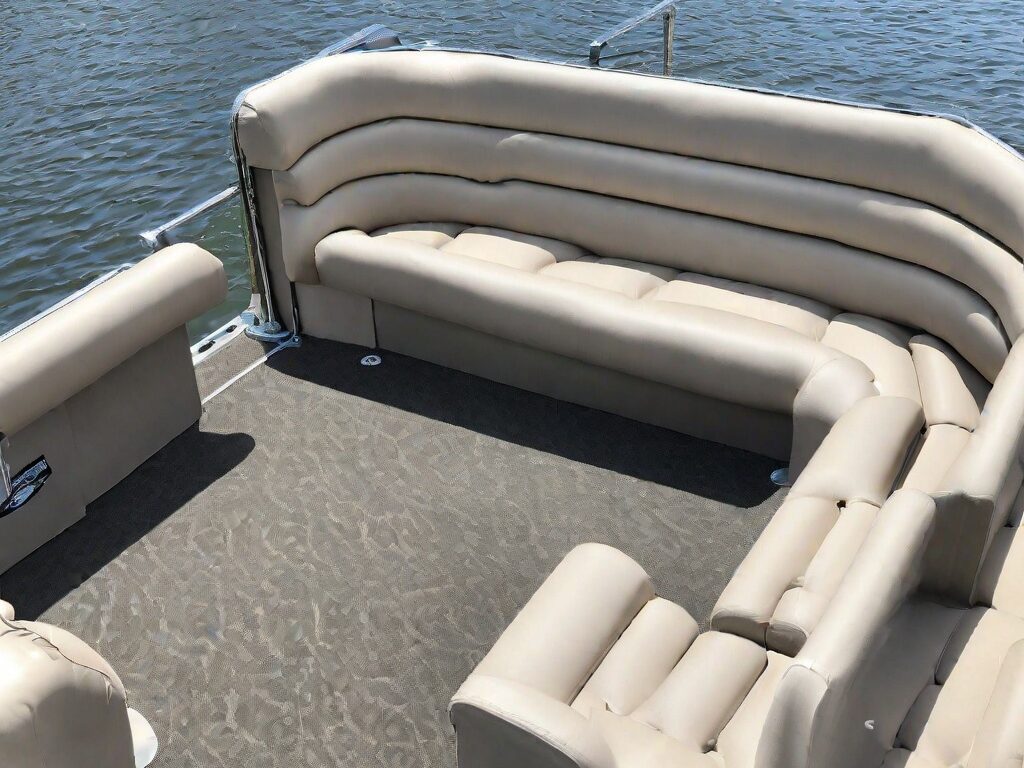
Marine Vinyl Flooring: Durable and Easy to Clean
Marine vinyl flooring is a fantastic option for pontoon boat owners who prioritize durability and ease of maintenance. Its robust construction ensures it can stand up to the rigors of boating life, making it a practical choice for a worry-free boating experience.
The benefits of marine vinyl flooring extend beyond its water-resistant properties. It’s also stain-resistant, ideal for fishing trips or entertaining guests. The non-porous surface means spills can be wiped away with ease, and the material’s resistance to fading keeps it looking fresh and new for years.
Durability and Maintenance
Marine vinyl flooring is renowned for its longevity, often outlasting the boat itself. It’s built to endure heavy foot traffic and resist wear and tear, ensuring it remains an attractive and functional part of your boat. Maintenance is as simple as a quick sweep or rinse, saving you time and effort.
Design and Texture Varieties
Today’s marine vinyl flooring comes in an array of designs and textures, allowing you to achieve the look of natural materials like teak or woven seagrass without the associated upkeep. This versatility means you can create a high-end, customized look that reflects your taste and enhances the overall appeal of your pontoon boat.
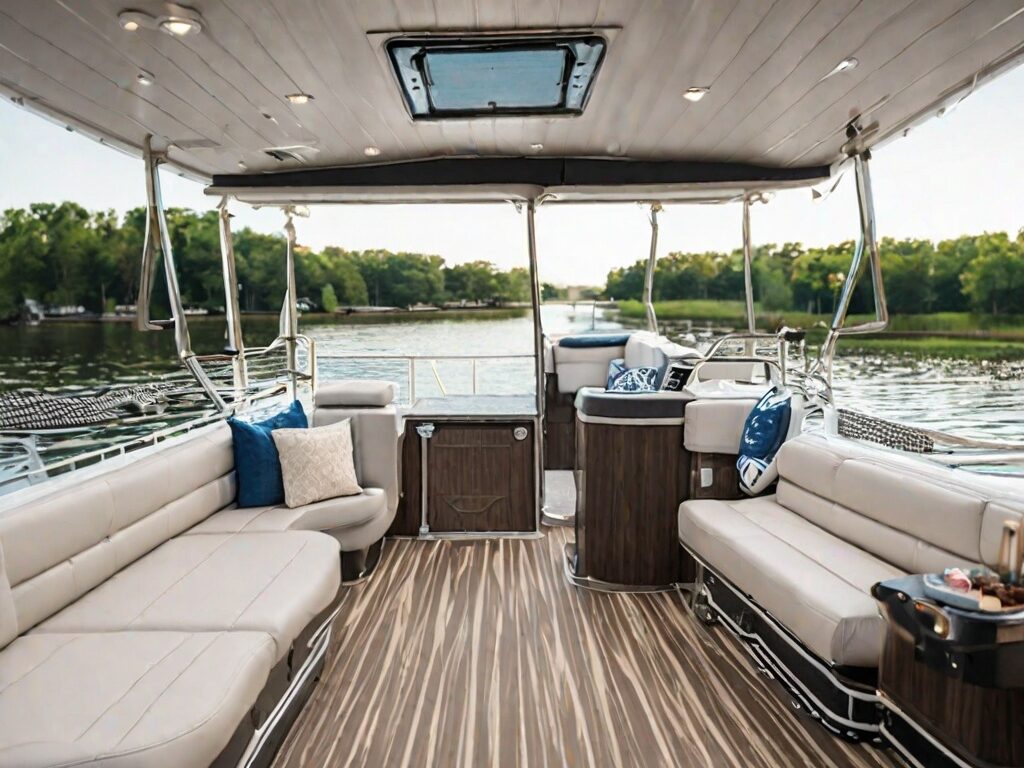
Marine Polyurethanes: The Protective Powerhouse
Marine polyurethanes represent the pinnacle of pontoon boat flooring options, offering unmatched protection and longevity. This innovative flooring solution creates a seamless barrier that’s impervious to water, weather, and wear.
Marine polyurethanes are a formidable defense against the elements. They provide a robust shield against abrasion, harsh chemicals, and the relentless sun, ensuring your flooring remains intact and vibrant. The seamless nature of the surface also means there are no crevices for dirt or moisture to hide, making it one of the most hygienic options available.
Application Process
The application of marine polyurethanes is a task best left to professionals. It involves a precise mix of components and a careful, even application to achieve a flawless finish. While the upfront cost and installation may be higher than other options, the unparalleled protection and longevity it offers make it a wise investment for the discerning boat owner.
Longevity and Aesthetic Appeal
Marine polyurethanes are not only about protection; they also offer aesthetic flexibility. Available in a spectrum of colors, they allow for personalization that can make your pontoon stand out on the water. The high-gloss finish adds a touch of luxury, elevating the overall look of your boat.
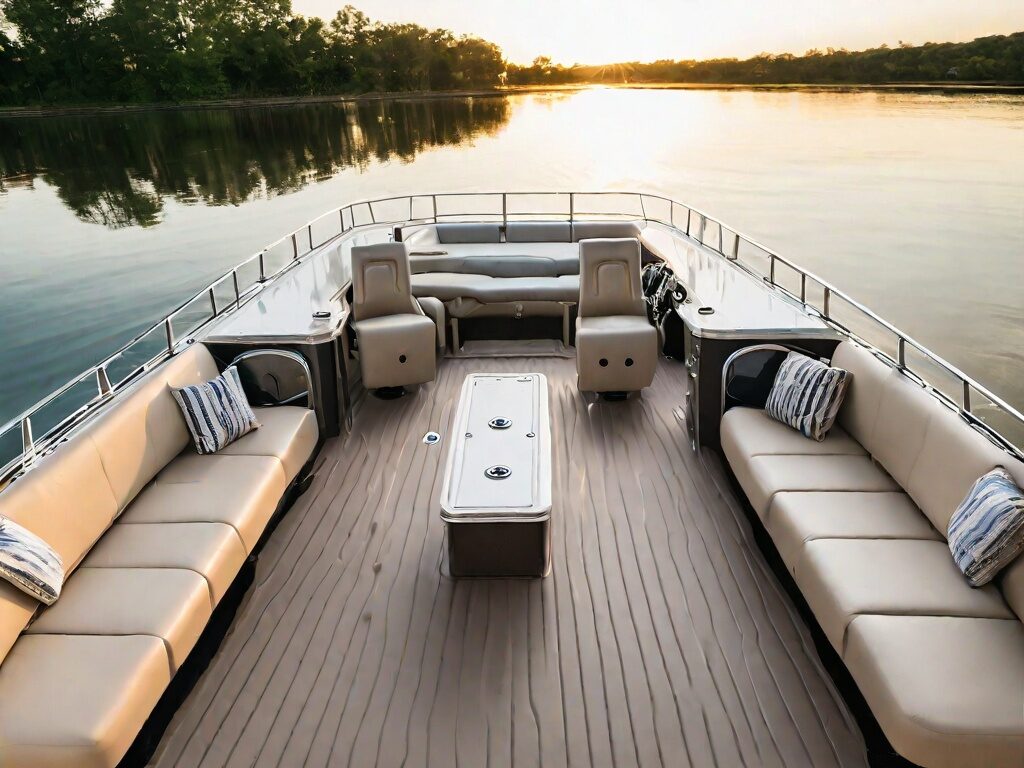
Comparison of Flooring Options
| Marine Grade Carpet | Marine Vinyl Flooring | Marine Polyurethanes | |
|---|---|---|---|
| Cost Comparison | Most cost-effective | Moderately priced, excellent value | Most expensive upfront, cost-effective long-term |
| Comfort and Safety | Soft surface, comfortable, good slip resistance | Comfortable, non-slip texture | Smooth, seamless surface, customizable slip resistance |
| Aesthetics and Style | Traditional look, various colors and patterns | Mimics natural materials, stylish designs | Sleek, modern finish, customizable aesthetics |
Installation Tips
Proper installation is crucial for maximizing the longevity and performance of your pontoon boat flooring. Whether you’re a seasoned DIY enthusiast or considering professional help, these tips will guide you through the process for a successful installation.
Preparing for Installation
- Cleanliness is Key: Start with a spotless deck. Remove all furniture, fixtures, and old flooring. Thoroughly sweep and wash the surface to remove any dirt, oil, or residue.
- Dry and Inspect: Ensure the deck is completely dry before installation. Inspect for any damage or areas that may need repair, as these can affect the integrity of your new flooring.
- Accurate Measurements: Measure the area multiple times for accuracy. Create a detailed diagram of your deck, noting any angles, curves, or cutouts.
- Material Acclimation: Allow your flooring material to acclimate to the boat’s environment for at least 24 hours before installation to prevent expansion or contraction post-installation.
DIY vs Professional Installation
- Skill Level Assessment: Honestly assess your skills and the complexity of the installation. Marine grade carpet and marine vinyl flooring are more forgiving for DIYers, while marine polyurethanes often require specialized equipment and expertise.
- Tool Preparation: Gather all necessary tools and materials before starting. This includes adhesives, rollers, cutters, and protective gear.
- Seek Guidance: Don’t hesitate to consult installation guides or watch instructional videos provided by flooring manufacturers. They can offer valuable insights and tips specific to their products.
Common Mistakes to Avoid
- Rushing the Process: Take your time with each step. Rushing can lead to misaligned patterns, improperly secured flooring, and potential waste.
- Ignoring Weather Conditions: Be mindful of the weather during installation. High humidity and temperature can affect adhesive drying times and material handling.
- Overlooking Edges and Corners: Pay special attention to the edges and corners of your flooring. These areas are prone to lifting and wear if not properly secured.
- Adhesive Application: Apply adhesives evenly and according to the manufacturer’s instructions. Inadequate or excessive adhesive can lead to issues down the line.
Post-Installation Tips
- Curing Time: Allow ample time for adhesives to cure fully before using the boat or replacing furniture. This can vary depending on the product and environmental conditions.
- Initial Maintenance: Clean the newly installed flooring to remove any installation residue. Follow the specific care instructions for your chosen material.
- Inspection: Conduct a thorough inspection of the installation. Check for any loose areas, bubbles, or imperfections that need to be addressed.
Long-Term Success
- Regular Checks: Periodically inspect your flooring, especially after heavy use or severe weather, to catch any potential issues early.
- Warranty Awareness: Be aware of your flooring’s warranty and the conditions that may void it, such as improper installation or use of unapproved cleaning products.
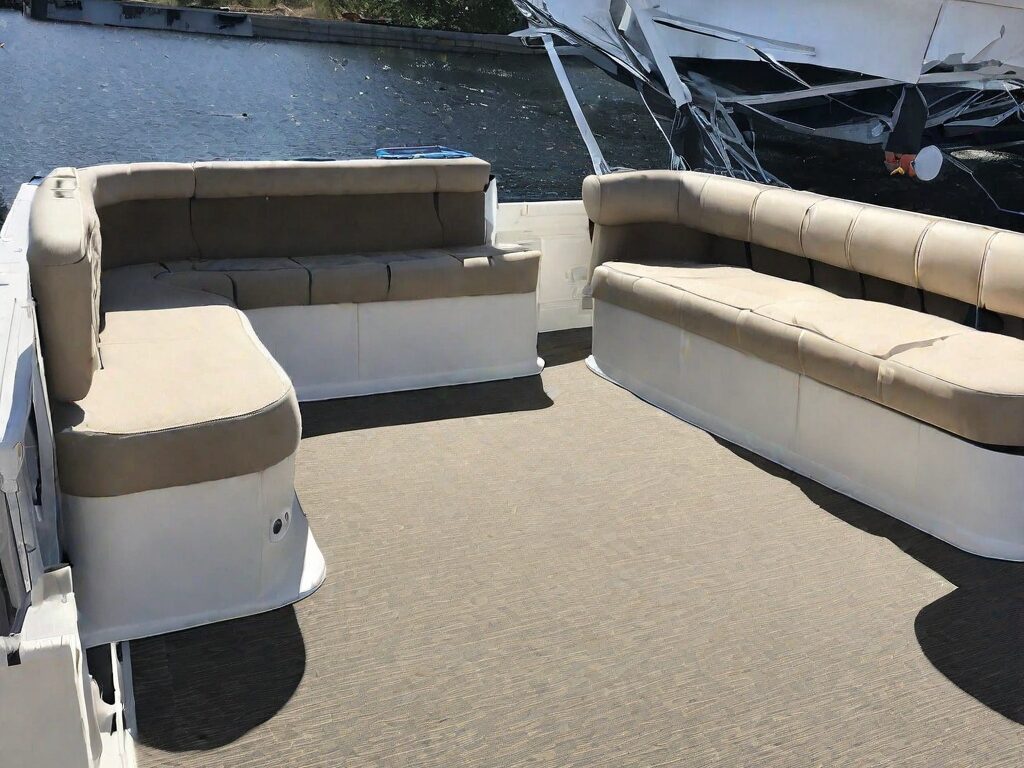
Safety Considerations
When selecting the flooring for your pontoon boat, prioritizing safety can make all the difference in ensuring a secure and enjoyable boating experience. Here are some expanded safety considerations to guide you in choosing the safest flooring option.
Non-Slip Surfaces
- Textured Surfaces for Traction: Opt for flooring with built-in texture or patterns that provide a non-slip surface. This is crucial for preventing accidents, especially when the deck becomes wet from water activities or weather conditions.
- Materials for Stability: Seek out materials known for their slip-resistant qualities. Some flooring options are designed with traction in mind, offering a safer walking surface even when the boat is rocking or in motion.
- Safety in All Conditions: Consider how the flooring performs in various scenarios, including when covered in water, bait, or fish scales during a fishing trip. The goal is to maintain stability and prevent slips in all situations.
Fire Resistance
- Fire-Resistant Materials: Choose materials that have inherent fire-resistant properties or are treated to be fire-retardant. This adds an extra layer of safety, reducing the risk of fire aboard your vessel.
- Compliance with Regulations: Verify that the flooring material meets or exceeds the safety standards and regulations for fire resistance. This not only ensures safety but may also be necessary for insurance purposes or to comply with local boating laws.
- Preventive Measures: Consider additional preventive measures, such as having fire extinguishers easily accessible on your pontoon boat. Regularly check and maintain these safety devices as part of your boating routine.
Weather Resistance
- Materials Built to Last: Select flooring materials that are designed to endure the extremes of your local climate. Whether it’s intense sunlight, heavy rain, or fluctuating temperatures, your flooring should be able to withstand these conditions without deteriorating.
- Climate Considerations: Tailor your choice to the typical weather patterns in your boating area. For example, if you’re in a region with high UV exposure, UV-resistant flooring is essential to prevent fading and weakening of the material.
- Seasonal Adaptability: Ensure that the flooring can adapt to seasonal changes. Some materials may become overly soft in high heat or brittle in cold temperatures, so it’s important to choose flooring that remains consistent throughout the seasons.
Conclusion
Selecting the right flooring for your pontoon boat is a crucial decision that affects both the look and feel of your vessel. Whether you choose marine grade carpet, marine vinyl flooring, or marine polyurethanes, each option offers its own set of advantages to enhance your boating experience. Consider your specific needs, budget, and environmental impact when making your choice, and enjoy the comfort and style that your new flooring brings to your pontoon boat adventures.

